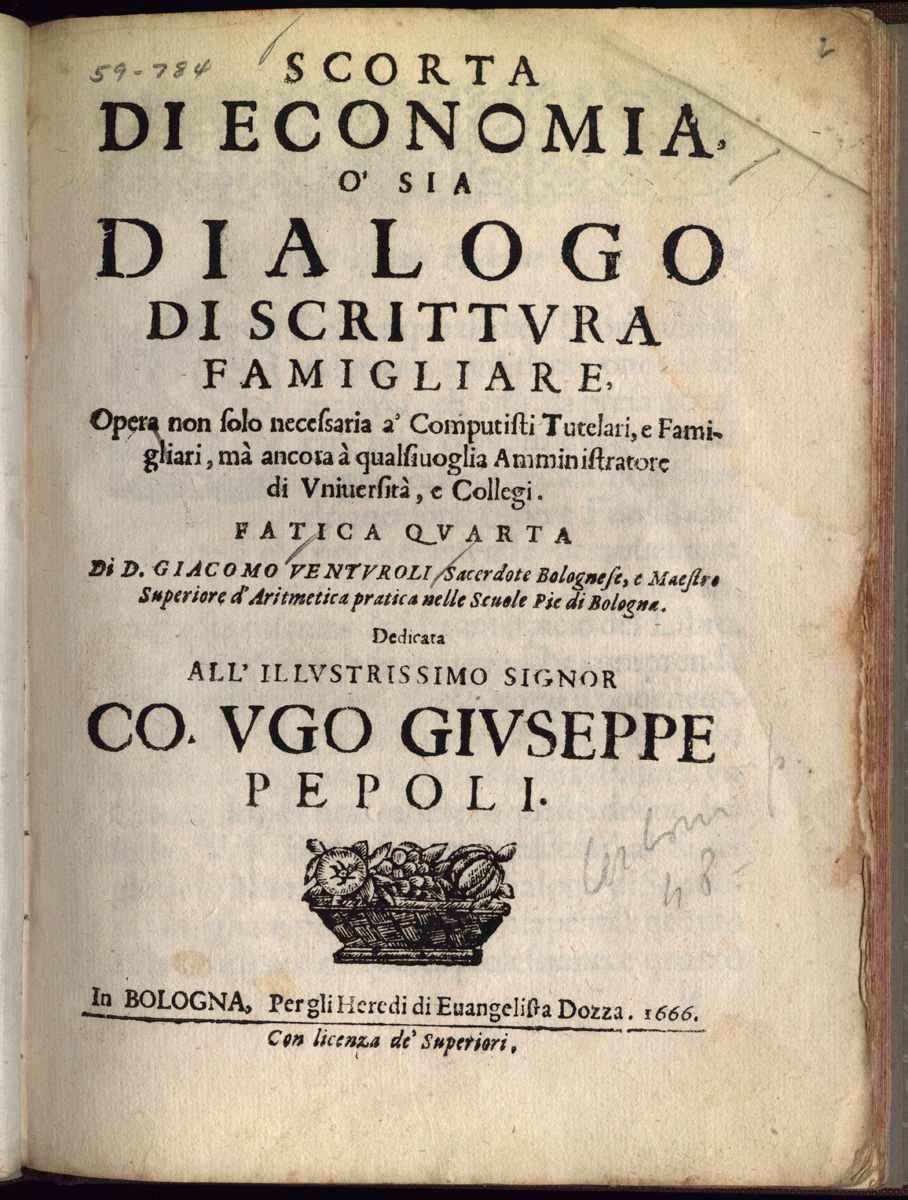6.06 Bookkeeping Textbooks
Tagliente's Luminario of 1525 had offered a brief introduction to bookkeeping based on the double-entry section of the Summa of Pacioli. Much more elaborate and more single-minded accounting textbooks were quickly produced, however, starting with the remarkable 1534 Double-Entry Ledger and Its Day-Book of Domenico Manzoni (dates unknown). Manzoni gave general and specialized rules for keeping a whole range of business ledgers, most of them derived from the bookkeeping section of Pacioli's Summa. Manzoni's most original contribution was that he illustrated the method with two, full-year specimen account books, first the daily account or day-book (giornale) and then the corresponding double-entry ledger (quaderno doppio). Double-entry, of course, was the pride of Venetian business culture, what Manzoni's title page advertises as the "practice of Venice." (35) Little is known of Manzoni except what he tells us in his prefaces, and that is next to nothing in strictly biographical terms. He came from Oderzo on the Venetian mainland and he affected a certain aristocratic and philosophical stance, but his book is supremely practical. He apparently taught mathematics in a Venice school and he authored other textbooks. (36)
Manzoni must have had good relations with his printer, Comin da Trino, for together they took considerable pains to make the specimen books (respectively forty and ninety-six pages in length) look realistic. Each has a mock-calligraphic title page that suggests how a merchant should open his blank ledger. The type in the body of the book is arranged in narrow columns to the left of each page to imitate the entry columns of the ledgers, and the empty spaces above and below entries are carefully filled with cancellation marks of the sort bookkeepers used to ensure that no false information was later supplied. The double-entry specimen reproduces the facing page format that all the bookkeeping teachers of the day recommended. Manzoni's precepts, like those of his principal source Pacioli, actually lagged some decades behind the current practice of the most sophisticated Venetian merchants. (37) This elaborate textbook, then, could have been intended in large part for an export market, to introduce the practices of the Adriatic metropolis to non-Venetians. Comin da Trino may have had the same market in mind for another bookkeeping manual with lengthy specimens, that of Alvise Casanova (dates unknown), published in 1558. Unlike Manzoni, Casanova does not seem to have been a schoolmaster. Instead he held several government accounting posts and practiced privately. Like Tagliente's Lucidario, Casanova's title boasted of the practical demonstrations on offer: A Most Bright Mirror in Which One May Observe Well Defined All the Types and Forms of Records That Should Be Kept in Business. (38)

Dozens of bookkeeping manuals were produced more or less on the same principle as Manzoni's and Casanova's well into the eighteenth century. Not all of them were so elaborate, however, and most in fact dispensed with the idea of providing a lengthy (and repetitive) specimen account book. It was more usual to set out each rule simply and exemplify each kind of entry just once or twice. One such popularization from the end of our period is Giacomo Venturoli's Guide to Economics, or rather, Dialogue on Everyday Bookkeeping, published at Bologna in 1666 and reprinted at least three times up to 1717. Venturoli (dates unknown) was a priest who taught "practical arithmetic" in the catechism schools at Bologna. Later he authored a successful elementary textbook under the title A Brief Compendium of All the Rules of Arithmetic. (39) Venturoli's bookkeeping manual falls into the tradition of Tagliente and Manzoni, but he cast this textbook in the form of a dialogue between father and son. The dialogue was a popularizing literary device and definitely not an imitation of humanist dialogues. The father-son interaction reinforced the notion that bookkeeping was essential to good family life. The son has been studying arithmetic for some time and now his hard-nosed father wants him to recite what he has learned, starting with definitions and progressing step by step. The book is summary (there are only seventy three pages of text), but it covers a fair amount, including many kinds of computations that can be accomplished using the data account books embody. The father repeatedly asks for general rules and then poses related problems to be solved. At the end he asks what kind of examinations the bookkeeping master administers, and his son replies with a very thorough list that is in effect the outline of a bookkeeping course.
NOTES Open Bibliography (330 KB pdf) (35) By the end of the sixteenth century, "in the Italian manner" was the usual way of describing double-entry; Parker 1984, 175-176; Ciocci 2003, 227. (36) There were at least five editions of Manzoni's book, but they are fairly rare and the relationship between them has never been studied. It is possible that the specimen sheets were not reprinted but reused in several editions. See also Trovato 1994, 43-44; Grendler 1989, 309, 320; Peragallo 1938, 60-66; Bariola 1897, 376-378; Cerboni 1886, 23. (37) This lag would bedevil accounting education for centuries afterward. Peragallo 1938, 73, 7--79; Macve 1996, 5-8, 19-20. (38) Casanova 1558. See Bariola 1897, 380-381; Peragallo 1938, 66-69; Jaffe 1999, 63-65. (39) Fantuzzi 1781, vol.8, 170.